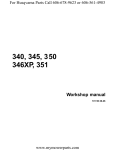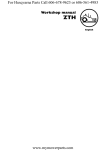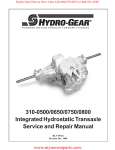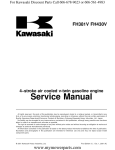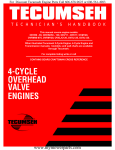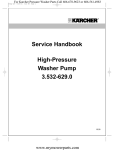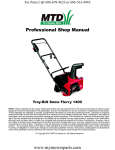Download Log Splitter Hydraulic Troubleshooting
Transcript
www.mymowerparts.com Log Splitter Hydraulic Troubleshooting Log Splitter Hydraulic Troubleshooting Test Kit # 759-3742 Test Kit Components. See Figure 1. 1. As a standard service procedure, replace the hydraulic oil filter._____ See Figure 1. Flow Meter Needle Valve Pressure Gauge Filter Figure 1 IMPORTANT: The following test kit information and systematic questioning allows diagnoses of the hydraulic log splitter. Proper testing and maintenance procedures provide safe and effective methods to do these tests. Use the blank lines “_____” to verify a performed step or record a test result. Make certain all the test results are recorded, there will be a need to refer back to them throughout this test. General Inspection IMPORTANT: Always disconnect the spark plug wire from the spark plug and ground it to the engine block when the log splitter is not being run. Figure 1 NOTE: When installing the hydraulic oil filter, lubricate the seal with hydraulic fluid, rotate the filter clockwise by hand until it is snug and complete the installation by rotating the filter 1/8 of a turn clockwise beyond the snug position. 2. Check the fluid level and add (or remove) fluid as required._____ NOTE: Check with the owner to find out what fluid is being used in the hydraulic log splitter. DO NOT mix hydraulic fluids. See Figure 2. Steel Rule Filler Opening Figure 2 9 - 14 K&T Saw Shop 606-678-9623 or 606-561-4983 www.mymowerparts.com Log Splitter Hydraulic Troubleshooting 3. Inspect the coupler assembly between the engine and the pump in the following sequence: See Figure 3. 5. Make certain there is a square key between the engine crankshaft and the upper coupling half._____ See Figure 4. Set Screw Coupler Assembly Square Key Figure 4 Figure 3 NOTE: Make certain the spark plug wire has been removed from the spark plug, and it is grounded to the engine block. Simply grasp the coupling assembly by hand and make certain the engine crankshaft and pump input shaft rotates with the coupling. 4. 6. Make certain there is a half-moon key between the pump input shaft and the lower coupling half._____ See Figure 5. Make certain the set screws in the upper and lower coupling halves are tight using an 1/8” allen wrench._____ NOTE: Remove and loctite the set screws if they are loose. Half Moon Key Nylon “Spider” Figure 5 NOTE: Refer to the Flexible Coupler Adjustment Section for instructions. 7. Make certain there is a nylon “spider” insert between the upper and lower coupling halves._____ 9 - 15 K&T Saw Shop 606-678-9623 or 606-561-4983 www.mymowerparts.com Log Splitter Hydraulic Troubleshooting 8. 12. Loosen the hose clamp securing the suction hose to the hydraulic gear pump using a 5/16” socket or a flat-blade screw driver. See Figure 6. Start the engine and verify that the engine is operating between 3500 and 3600 RPM using a tachometer._____ See Figure 8. Pump Clamp Hose Figure 8 Figure 6 9. NOTE: See the engine service manual for correct RPM specifications and procedures. Momentarily remove the suction hose from the bottom of the pump and lower it into an oil drain container, making certain there is sufficient flow from the reservoir._____ See Figure 7. 13. Shut the engine off. Pump Troubleshooting Pump 1. Latch the log splitter in the horizontal position._____ See Figure 1. High Pressure Hose Low Pressure Hose Latch Figure 7 10. Quickly reconnect the suction hose and secure it in place using a 5/16” socket._____ 11. Check the fluid level and replace the lost fluid._____ Figure 1 9 - 16 K&T Saw Shop 606-678-9623 or 606-561-4983 www.mymowerparts.com Log Splitter Hydraulic Troubleshooting 2. Test Kit Installation Procedures With the log splitter off, cycle the control valve forward and rearward several times to relieve any pressure in the hydraulic system._____ See Figure 2. NOTE: The pressure gauge side of the test kit connects to the pump’s high pressure hydraulic hose, and the flow gauge side of the test kit connects to the inlet port of the control valve. See Figure 1. Male Union to control valve Control Valve Female union to high pressure hose Figure 2 3. Male union Remove the high pressure hydraulic hose from the inlet port of the control valve using channel locks and a (1 and 1/8”) wrench._____ Figure 1 Control Valve to Flow Meter Connector NOTE: Make certain that any dirt or debris is removed from the hydraulic connections before they are loosened. 4. Set the high pressure hydraulic hose into an oil drain container. 1. Secure the male union to the inlet side of the control valve using a 1-1/8” wrench and a large adjustable wrench to hold the control valve._____ 2. Secure the male union to the flow meter connector using a 1-1/8” wrench and a 7/8” wrench._____ See Figure 2. Control Valve Inlet Pressure Gauge Pressure Line Flow Valve Figure 2 9 - 17 K&T Saw Shop 606-678-9623 or 606-561-4983 www.mymowerparts.com Log Splitter Hydraulic Troubleshooting High Pressure Hydraulic Hose to Pressure Gauge Connector 1. Secure the male union, female union, and high pressure hydraulic hose connector to the pressure gauge connector using a 1-1/8” wrench, 11/16” wrench, 7/8” wrench, and a large adjustable wrench._____ 2. Double check all connectors and make certain they are tight before performing the test procedures._____ valve that is used on the test kit, the GOLD ring below the needle valve knob will be exposed, or the number “4” will be showing on the center indicator. See Figure 2. Test Procedures IMPORTANT: When instructed to close the needle valve, extreme caution must be exercised. Leaving the needle valve closed can blow seals and damage the log splitter. See Figure 1. Gold Ring High PSI when running Figure 2 2. Start the engine and move the throttle (if equipped) to fast._____ NOTE: Most log splitters do not have a throttle control, they are set to run at full throttle at all times. Needle Valve Closed Figure 1 1. Open the needle valve completely by turning the knob counter-clockwise._____ NOTE: The needle valve MUST be open before starting the log splitter. Depending on the needle 9 - 18 K&T Saw Shop 606-678-9623 or 606-561-4983 www.mymowerparts.com Log Splitter Hydraulic Troubleshooting 3. Check the engine RPM with a tachometer and make certain the engine is running between 3500 and 3600 RPM._____ See Figure 3. 6. Record the pressure of the fluid at the pressure gauge._____ NOTE: The pressure gauge should read 0 PSI (pounds-per-square-inch) if the pump is operating correctly. 7. Slowly close the needle valve clockwise until the engine begins to labor._____ 8. Continue to close the needle valve slowly until the high volume check valve closes and the engine RPM returns to normal._____ See Figure 5. Figure 3 NOTE: If the engine is not running to specifications, the test results will not be valid. See the engine service manual to correct the engine RPM. 4. The log splitter must be run for a short time to bring the hydraulic fluid up to 130 degrees Fahrenheit before continuing this test._____ 5. Record the GPM of the fluid flow at the flow meter._____ See Figure 4. 1-3 GPM 300 -700 PSI Figure 5 9. Record the PSI._____ NOTE: The PSI reading should be between 300 and 700 PSI. 10. 8-14 GPM Record the GPM._____ NOTE: The GPM reading should be between 1 and 3 GPM. IMPORTANT: If the check valve does not close, the engine will bog down and stall. (REPLACE THE PUMP). 11. 0 PSI Figure 4 If all the recorded data meets the specifications above, proceed._____ CAUTION: The next test requires the needle valve to be almost fully closed. It must be opened immediately after recording the test results to avoid damage._____ NOTE: The flow meter should read between 8 and 14 GPM (gallons-per-minute) if the pump is operating correctly. 9 - 19 K&T Saw Shop 606-678-9623 or 606-561-4983 www.mymowerparts.com Log Splitter Hydraulic Troubleshooting Final Pump Pressure Test 1. • Continue to close the needle valve slowly until the flow gauge reads approximately 1 GPM._____ See Figure 1. Scan the Final Pump Pressure Test section and enter the recorded test result from PSI “A”_____ and GPM “A”_____ Test Procedures 1. Make certain the needle valve is fully open._____ See Figure 1. 1500-3200 PSI 1-3 GPM Figure 1 Needle valve “Open” NOTE: DO NOT close the needle valve fully. This is the main pressure hose, and the pump does not have a relief valve. 2. Figure 1 Record the PSI._____ This is PSI “A” NOTE: The PSI “A” should be between 1500 and 3200 PSI. 3. 2. Start the log splitter._____ 3. Move the control valve handle to the forward position until the wedge assembly is at the end of its travel._____ See Figure 2. Record the GPM._____ This is GPM “A” NOTE: The GPM “A” should be approximately 1 GPM. 4. Immediately open the needle valve._____ NOTE: Damage to the pump can be avoided by opening the needle valve immediately after recording the test results. 5. If the PSI reading is below 1500 PSI and the GPM is above 1 to 2, the pump is defective. (REPLACE THE PUMP). 6. Shut the log splitter off. 7. If all the recorded data meets the specifications above, perform the following section. Hold control valve in FORWARD position Control Valve and Hydraulic Cylinder Troubleshooting Figure 2 NOTE: This section is to be used after the General Inspection and Pump Troubleshooting sections have been performed._____ 4. Hold the control valve handle in the forward position. 9 - 20 K&T Saw Shop 606-678-9623 or 606-561-4983 www.mymowerparts.com Log Splitter Hydraulic Troubleshooting 5. Record the PSI._____ (This is PSI “B”) See Figure 3. 13. Move the control valve to reverse and retract the wedge assembly. 14. Shut the log splitter off and relieve the pressure in the hydraulic system by cycling the control valve handle forward to reverse several times. 15. Remove the test kit from the log splitter using a 7/8” wrench, 1-1/8”, 1-1/16” and a large adjustable wrench. Low flow, high pressure Needle valve “Open”, wedge bottomed out Figure 3 NOTE: The PSI “B” recorded should be equal to or GREATER than the PSI “A” recorded earlier in the Pump Troubleshooting section - Final Pump Pressure Test. 6. Record the GPM._____ (This is GPM “B”) 7. Enter the recorded test results from GPM “A”_____ and GPM “B”_____ 8. If the recorded GPM “B” is equal to or LESS than the (GPM “A”) recorded earlier in the Pump Troubleshooting section - Final Pump Pressure Test, the hydraulic fluid flow is correct. 9. If the recorded GPM “B” is GREATER than the (GPM “A”) recorded earlier in the Pump Troubleshooting section - Final Pump Pressure Test, there may be a problem with the control valve, pressure relief valve, or hydraulic cylinder. 10. Enter the recorded test results from PSI “A”_____ and PSI “B”_____ 11. If the (PSI “B”) is equal to or greater than the recorded (PSI “A”) in the Final Pump Pressure Test, the hydraulic system is functioning correctly. 12. Remove Test Kit Figure 4 16. Install the high pressure hydraulic hose in the inlet port of the control valve using a 1-1/16” wrench and channel locks. See Figure 5. High pressure line re-installed If the (PSI “B”) is less than the recorded (PSI “A”) in the Final Pump Pressure Test, there may be a problem with the control valve, pressure relief valve or hydraulic cylinder. Continue through this section to determine which part is faulty. Figure 5 9 - 21 K&T Saw Shop 606-678-9623 or 606-561-4983 www.mymowerparts.com Log Splitter Hydraulic Troubleshooting Control Valve, Pressure Relief Valve and Hydraulic Cylinder Testing 1. Install the Test Kit in the following sequence Make certain the wedge assembly is in the fully retracted position._____ See Figure 1. To rear port of hydraulic cylinder (Flow side of kit) To control valve outlet (Pressure side of kit) Figure 1 NOTE: The pressure gauge side of the test kit connects to the control valve, and the flow gauge side of the test kit connects to the rear port of the hydraulic cylinder. Figure 1 2. 3. Place the log splitter in the vertical position and lock it in._____ Rear Cylinder Port to Flow Meter Connector. Remove the steel hydraulic tube that connects from the rear port of the hydraulic cylinder to the 90 degree fitting on the control valve using two 7/ 8” wrenches._____ See Figure 2. 1. Secure the flow gauge connector directly to the rear port of the hydraulic cylinder using a 7/8” wrench._____ Rear of hydraulic cylinder 90 degree fitting Steel hydraulic tube Figure 2 9 - 22 K&T Saw Shop 606-678-9623 or 606-561-4983 www.mymowerparts.com Log Splitter Hydraulic Troubleshooting Control Valve 90 Degree Fitting to Pressure Gauge Connector: 1. Secure the male to female union, male union and small high pressure hydraulic hose to the pressure gauge connector using a 1-1/8” wrench, 11/16” wrench, 7/8” wrench, and a large adjustable wrench._____ 2. Double check all connectors and make certain they are tight before performing the test procedures._____ 3. 6. Momentarily close the needle valve completely, record the PSI gauge and immediately open the needle valve back up._____ See Figure 1. Close needle valve slowly, then open quickly after taking reading. Secure the open end of the small high pressure hydraulic hose to the 90 degree fitting on the control valve using two 7/8” wrenches. Test Procedures IMPORTANT: When instructed to close the needle valve, extreme caution must be exercised. Leaving the needle valve closed for more than a few seconds can blow seals and damage the log splitter. 1. Scan the above section and enter the recorded test result from PSI “B”_____ 2. Rotate the needle valve counter-clockwise to the completely open position._____ 3. Start the engine and move the throttle (if equipped) to fast._____ Figure 1 CAUTION: This step must be performed very quickly or damage may occur to the hydraulic system. NOTE: Most log splitters do not have a throttle control, they are set to run at full throttle. 4. Move the control valve handle to the forward position until the wedge assembly is at the end of its travel._____ 5. Hold the control valve handle in the forward position and begin to close the needle valve. 7. Record the PSI._____ This is (PSI “C”). 8. Enter the recorded test results from PSI “B”_____ and PSI “C”_____ 9. If the recorded PSI “C” is equal to the PSI recorded earlier (PSI “B”), the pressure relief valve is functioning correctly._____ 10. If the recorded PSI “C” is equal to the PSI recorded earlier (PSI “B”), but exceeds the 3200 PSI limit, the Pressure Relief Valve Adjustment section must be performed to lower the PSI._____ 11. If the recorded PSI “C” is below the PSI recorded earlier (PSI “B”), the Pressure Relief Valve Adjustment section must be performed in an attempt to bring the PSI back into the correct specifications before condemning the control valve. 12. Shut the log splitter off._____ 9 - 23 K&T Saw Shop 606-678-9623 or 606-561-4983 www.mymowerparts.com Log Splitter Hydraulic Troubleshooting Pressure Relief Valve Adjustment 6. Depending on the log splitter pressure, turn the adjustment screw clockwise or counterclockwise 1/8 of a turn using a flat-blade screw driver. See Figure 2. Screwdriver Clockwise INCREASES pressure Pressure relief valve cap Counterclockwise DECREASES pressure Figure 1 Figure 2 IMPORTANT: This adjustment is extremely sensitive. Slowly turn the adjustment screw one eighth of a turn at time and recheck the pressure. 1. Enter the recorded test results from PSI “B”_____ 2. Rotate the needle valve counter-clockwise to the completely open position._____ 3. Remove the hex bolt covering the pressure relief valve using a 5/8” wrench. 4. Inspect the “O” ring on the hex bolt for damage or wear._____ 5. Mark the orientation of the adjustment screw on the outer housing using a flashlight and a sharp object. NOTE: Turning the adjustment screw clockwise increases the pressure. Turning the adjustment screw counter-clockwise decreases the pressure. 7. Start the engine and move the throttle (if equipped) to fast._____ NOTE: Most log splitters do not have a throttle control, they are set to run fast all the time. 8. Move the control valve handle to the forward position until the wedge assembly is at the end of its travel._____ 9 - 24 K&T Saw Shop 606-678-9623 or 606-561-4983 www.mymowerparts.com Log Splitter Hydraulic Troubleshooting 9. Hold the control valve handle in the forward position and begin to close the needle valve. See Figure 3. 17. Repeat the above section and continue to make eighth turn adjustments until the correct pressure relief specifications have been achieved. NOTE: Always shut the log splitter off when making adjustments. Close needle valve slowly, then open quickly after taking reading. 18. If the pressure relief valve has been adjusted to the correct specifications, the control valve is good. Perform the Hydraulic Cylinder Troubleshooting section. 19. If the pressure relief valve will not adjust to the correct specifications, REPLACE THE CONTROL VALVE. See Figure 4. Figure 3 10. Momentarily close the needle valve completely, record the PSI gauge and immediately open the needle valve back up._____ CAUTION: This step must be performed very quickly or damage may occur to the hydraulic system. 11. Record the PSI._____ The new pressure reading is (and replaces the previous reading) (PSI “C”). 12. Enter the recorded test results from PSI “B”_____ and the new PSI “C”_____ 13. If the recorded PSI “C” is equal to the PSI recorded earlier (PSI “B”), the pressure relief valve is functioning correctly, and this is now the Final PSI “C”._____ Continue to the Hydraulic Cylinder Troubleshooting section. 14. If the recorded PSI “C” is equal to the PSI recorded earlier (PSI “B”), but exceeds the 3200 PSI limit, the Pressure Relief Valve Adjustment section must be performed to lower the PSI._____ 15. If the recorded PSI “C” is below the PSI recorded earlier (PSI “B”), the Pressure Relief Valve Adjustment section must be performed in an attempt to bring the PSI back into the correct specifications before condemning the control valve. 16. Shut the log splitter off. Figure 4 20. Shut the log splitter off. Hydraulic Cylinder Troubleshooting. IMPORTANT: This section is to be performed after all the other Test Kit sections have been performed. 1. Enter the recorded test results from the reading Final PSI “C”_____. 9 - 25 K&T Saw Shop 606-678-9623 or 606-561-4983 www.mymowerparts.com Log Splitter Hydraulic Troubleshooting 2. Rotate the needle valve counter-clockwise to the completely open position._____ See Figure 5. NOTE: Seal kits are available from your parts suppliers. See Figure 6. Needle valve in “Open” position Seals Cylinder Piston Figure 5 3. Retaining Ring Figure 6 Start the engine and move the throttle (if equipped) to fast._____ NOTE: Most log splitters do not have a throttle control, they are set to run at full throttle. 4. Move the control valve handle to the forward position until the wedge assembly is at the end of its travel._____ 5. Hold the control valve handle in the forward position. 6. Record the PSI._____ (This is PSI “D”) 7. Record the GPM._____ 8. Enter the recorded test results from Final PSI “C”_____ and PSI “D”_____ 9. If the recorded PSI “D” is EQUAL to the PSI recorded earlier (PSI “C”), and the recorded GPM is between 0 and 1, the cylinder is good. 10. If the recorded PSI “D” is LESS than the PSI recorded earlier Final (PSI “C”), and the recorded GPM is 2 to 3 or more, the hydraulic cylinder needs to be repaired. 11. Replace the hydraulic cylinder ONLY if repairs are not possible. 12. Remove the hydraulic log splitter test kit using a 7/8” wrench, 1 - 1/16” wrench, 1 - 1/8” wrench, and a large adjustable wrench._____ 13. Install the steel hydraulic tube that connects from the rear port of the hydraulic cylinder to the 90 degree fitting on the control valve using two 7/8” wrenches._____ 9 - 26 K&T Saw Shop 606-678-9623 or 606-561-4983















